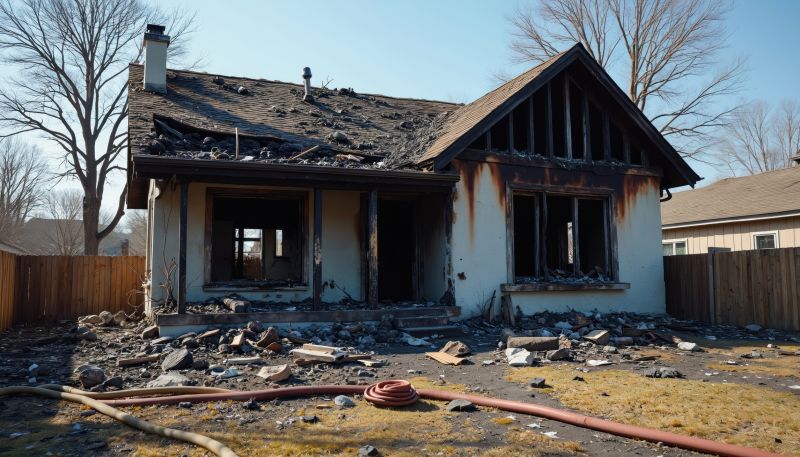Favorite Fire Restoration Tools For Safe And Effective Cleanup
Browse trusted equipment designed to facilitate safe, efficient, and thorough fire damage restoration.
 Fire restoration is a complex process that requires specialized products to effectively address damage caused by flames, smoke, and heat. Restorers often need a combination of cleaning agents, odor neutralizers, and structural repair materials to bring a property back to its pre-fire condition. The selection of appropriate products is crucial in ensuring safety, efficiency, and thoroughness during the restoration process. From cleaning soot and smoke residues to sealing porous surfaces and eliminating persistent odors, each product plays a vital role in achieving satisfactory results.
Fire restoration is a complex process that requires specialized products to effectively address damage caused by flames, smoke, and heat. Restorers often need a combination of cleaning agents, odor neutralizers, and structural repair materials to bring a property back to its pre-fire condition. The selection of appropriate products is crucial in ensuring safety, efficiency, and thoroughness during the restoration process. From cleaning soot and smoke residues to sealing porous surfaces and eliminating persistent odors, each product plays a vital role in achieving satisfactory results.
Types of Products For Fire Restorations
Soot and Smoke Cleaners
Products formulated to remove soot and smoke residues from walls, ceilings, and other surfaces, ensuring thorough cleaning and odor reduction.
Odor Neutralizers
Specialized solutions designed to penetrate porous materials and neutralize persistent odors caused by smoke and fire damage.
Fire-Resistant Sealants
Sealants used to block smoke and heat transfer, providing a protective barrier on surfaces and structural elements.
Structural Repair Materials
Materials such as fire-resistant drywall, plaster, and framing components used to restore structural integrity.
Electrostatic Sprayers
Devices that evenly distribute cleaning and deodorizing solutions across surfaces for efficient coverage.
Dehumidifiers and Air Scrubbers
Equipment used to remove excess moisture and airborne contaminants, improving air quality during restoration.
Heat-Resistant Gloves
Protective gear essential for handling hot materials and working safely during fire damage cleanup.
Fire-Resistant Insulation
Insulation materials that help prevent further fire spread and improve energy efficiency.
Cleaning Cloths and Sponges
Absorbent and durable cloths designed for wiping surfaces and applying cleaning solutions.
Smoke Dampers
Devices installed in HVAC systems to prevent smoke and fumes from spreading during restoration.
Fire-Resistant Paints
Coatings that provide additional fire resistance to walls and ceilings after cleaning and repairs.
Odor Absorbing Gels
Gels that absorb and neutralize airborne odors in enclosed spaces.
Electrostatic Disinfectants
Disinfectants applied via electrostatic sprayers to sanitize surfaces and reduce microbial growth.
Fire-Resistant Boards
Panels used in rebuilding and structural repairs that offer enhanced fire resistance.
Soot Sponges
Specialized sponges that lift soot without smearing, ideal for delicate surfaces.
Popular Choices
Widely used for removing residues from various surfaces during fire damage cleanup.
Highly sought after for their effectiveness in eliminating stubborn smoke smells.
Commonly employed to control moisture levels and prevent mold growth post-fire.
Popular for filtering airborne contaminants and improving indoor air quality.
Frequently used in sealing cracks and preventing further smoke infiltration.
Preferred for their efficiency in applying cleaning and disinfectant solutions evenly.
Commonly selected for rebuilding efforts to enhance safety and energy efficiency.
Essential in HVAC systems for preventing smoke spread during restoration.
Popular for their ability to absorb and neutralize airborne odors in enclosed spaces.
Frequently used in structural repairs for added fire protection.
Preferred for gentle soot removal from delicate surfaces without smearing.
Restoration professionals typically begin with soot and smoke removal, which can be achieved through various cleaning solutions designed to break down residues without damaging surfaces. Odor control is another critical aspect, often requiring specialized neutralizers that can penetrate porous materials and eliminate lingering smells. Structural repairs may involve sealants and fire-resistant materials that help prevent future damage and ensure the integrity of the restored property.
When choosing products for fire restoration, it is important to consider the specific types of surfaces involved, the extent of damage, and the safety data of each product. Proper ventilation and protective equipment are also essential during application to safeguard workers from potentially hazardous fumes or residues. The right combination of products can streamline the restoration process, reduce costs, and improve overall outcomes for property owners and restoration teams alike.
Key Buying Considerations
- Compatibility with different surfaces and materials involved in the restoration process.
- Effectiveness of the product in removing soot, smoke, and odor residues.
- Safety data and handling instructions to protect workers and occupants.
- Ease of application, including whether tools like sprayers or brushes are needed.
- Drying times and how they impact overall project timelines.
- Durability and long-term effectiveness of sealants and fire-resistant materials.
- Regulatory compliance and certifications relevant to fire safety standards.
- Cost considerations balanced with product performance and coverage area.
- Availability of replacement parts or refills for equipment like sprayers and air scrubbers.
- Environmental conditions of the restoration site, such as humidity and ventilation.
- Compatibility with existing building materials during structural repairs.
- User reviews and professional recommendations for proven performance.
- Storage requirements and shelf life of products for inventory management.
- Potential health hazards or fumes produced during application.
- Support and guidance from manufacturers or suppliers for best results.
This page contains affiliate links. We may earn a commission from qualifying purchases, which helps support our content and services.
